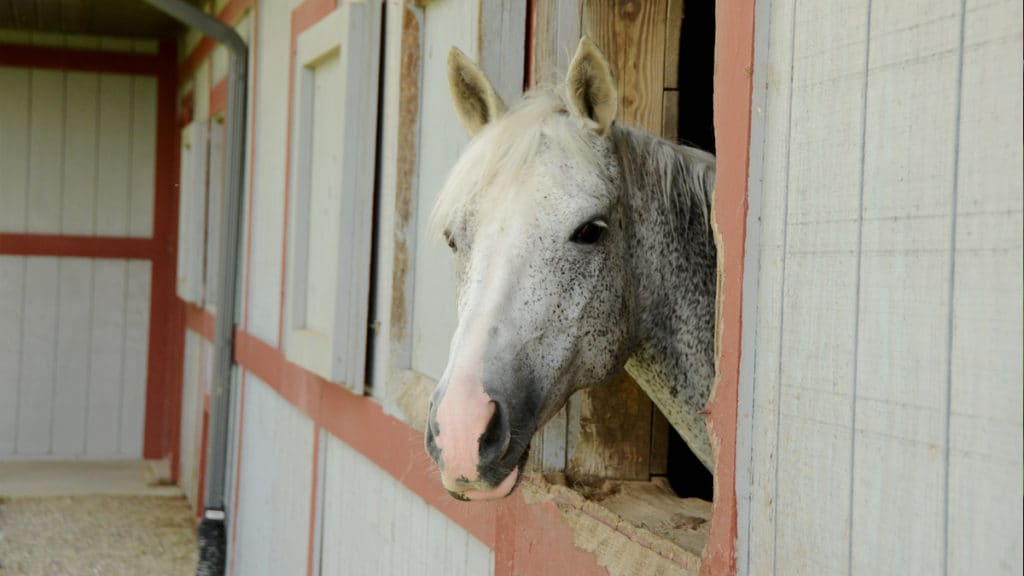Like any other animals, horses, donkeys and mules have their own set of species-specific infections that can develop and spread amongst them. Strangles in horses, also known as equine distemper, is “an upper respiratory bacterial infection caused by the bacterium Streptococcus zooepidemicus var. equi, formerly known as Streptococcus equi,” says Dr. Douglas Thal, DVM, owner of Thal Equine and Diplomate of the American Board of Veterinary Practitioners. “The name ‘strangles’ comes from the fact that when abscesses become large, they can exert pressure on the upper airway, causing respiratory noise, and rarely, difficulty breathing,” adds Dr. Thal. Marked by its highly contagious nature and shocking appearance, horse strangles is actually a common infection with a notably good prognosis.
What are the symptoms of strangles in horses?
Dr. Thal notes that, “The disease manifests as classic large swellings under and behind the jaw—abscessation of the lymph nodes. These swellings grow until—in most cases—they finally rupture, draining yellow pus for days to a week before finally healing from the inside out.” Due to the location of the open wounds, it is recommended to feed hay and grain on the ground, encouraging the horses to lower their heads and promote drainage.
Due to the physical and emotional toll that horse strangles takes, working closely with a veterinarian can speed up the healing process. “Horses with strangles often also have a cough, fever and nasal discharge,” explains Dr. Thal, “They are depressed and may not each much, especially as the abscesses are growing,” so a speedy recovery is imperative to their spirit and well-being.
How does horse strangles spread?
Strangles is highly contagious and transmissible between horses through direct, or indirect, contact; specifically, contact with horse care professionals clearing drainage or secretions from a sick equine. Keeping sick horses isolated is the best way to contain the disease within a barn; however, “Once there has been an outbreak at a facility, the facility is considered strangles endemic, and horses visiting there are at risk of contracting the disease,” warns Dr. Thal.
Keeping a separate set of horse care grooming equipment, such as the Oster Equine Care 7-Piece Grooming Kit for Horses, for each horse in a barn and not sharing tack are good habits to practice to help mitigate the risk of spreading diseases like equine distemper. “[Strangles in horses] can also be transmitted through contact with handlers, unknowingly transporting the bacteria on hands, equipment or clothes,” continues Dr. Thal. “The bacteria can persist in the environment around a facility for months to years.” Sanitizing hands, equipment and even clothing is vital to keeping strangles contained, especially when traveling between facilities.
How is horse strangles treated?
Because horses are herd animals, once one horse at a barn contracts equine distemper, it is common for it to be transmitted throughout the others before you even notice symptoms. “Once a horse contracts strangles, in most cases, it will just take time to heal,” says Dr. Thal. “The use of antibiotics is controversial [and is] usually reserved for after abscesses become large and prior to rupture. Vets often open these abscesses, providing drainage and relief to the horse. Once abscesses break and drain, horses often act normal, and the swelling drastically decreases.” Due to the strain that the infection takes on a horse’s body, it is important to give him time to rest and heal without strenuous exercise.
How can you prevent strangles in horses?
While there are equine distemper vaccinations, Dr. Thal clarifies that they can be problematic due to the risk of complications or lack of efficacy. “The most important part of prevention is avoiding exposure to the bacteria. General immunity is maintained [with] general health—good nutrition and preventative care,” explains Dr. Thal.
Due to horse strangles being highly contagious, once there has been an outbreak at a facility, it is best to limit any contact between horses and keep any horses from coming to or leaving the facility until a veterinarian has declared the outbreak over. Proper horse care and preventative measures, such as quarantine when a new horse arrives at your barn, will help mitigate the risk of equine distemper.
Share:










